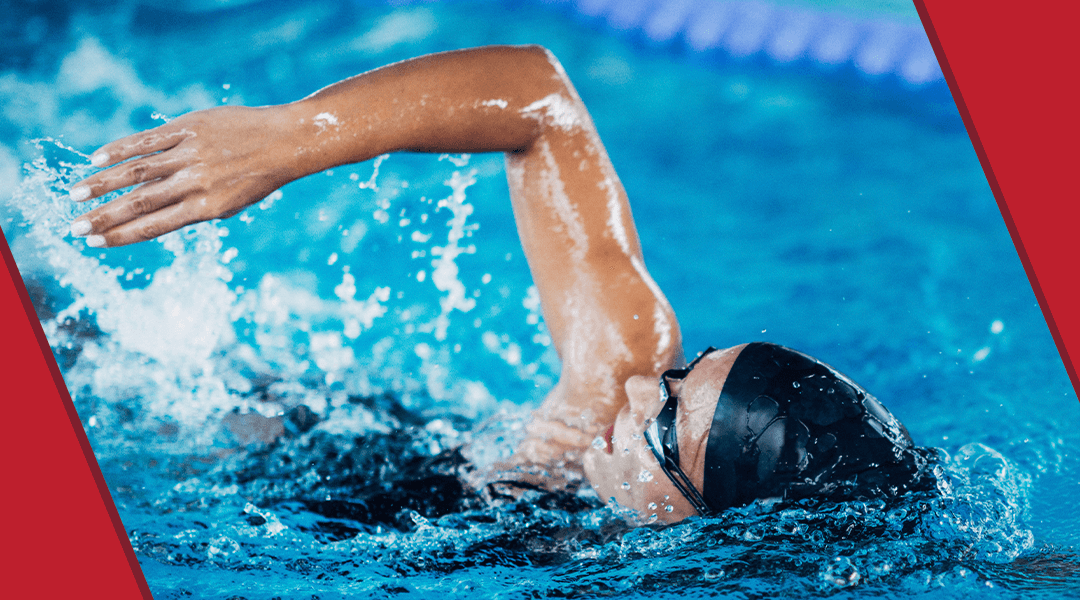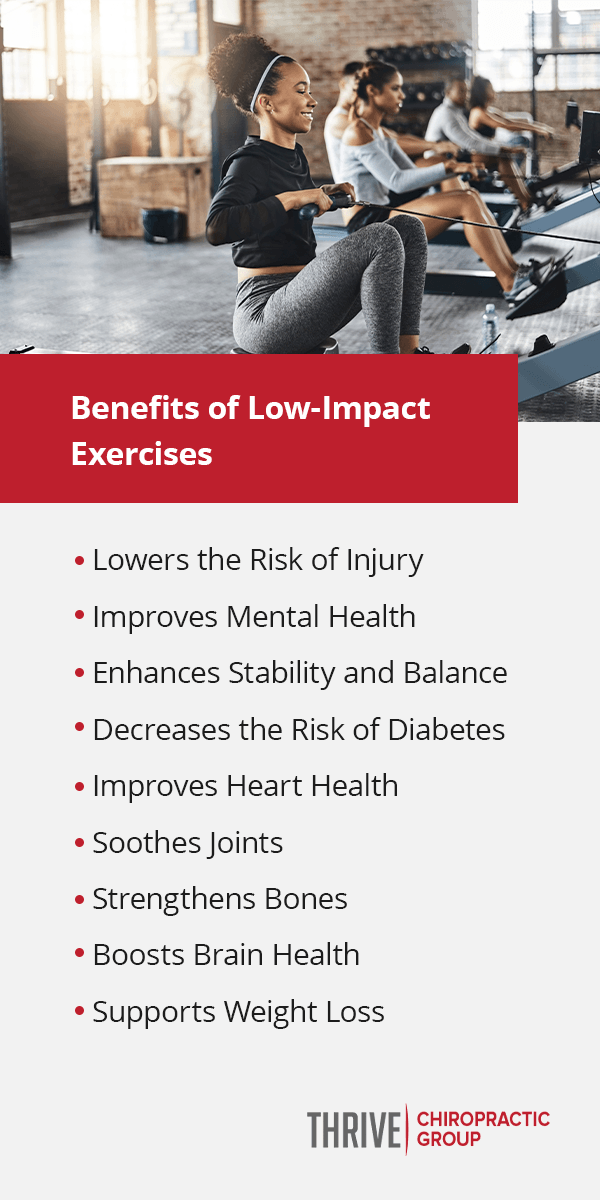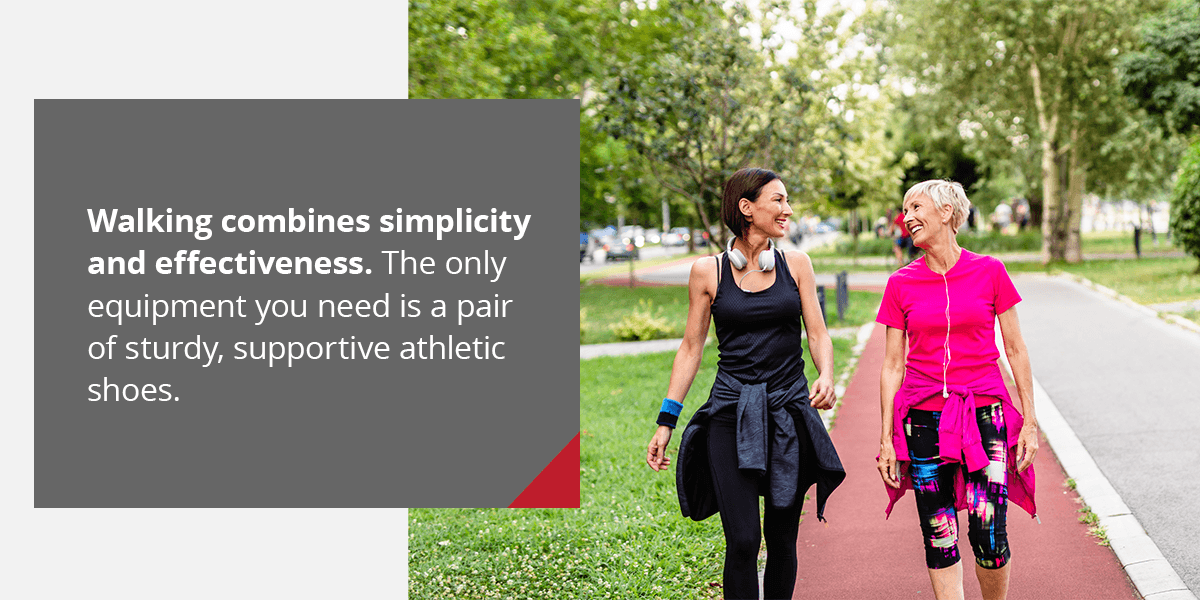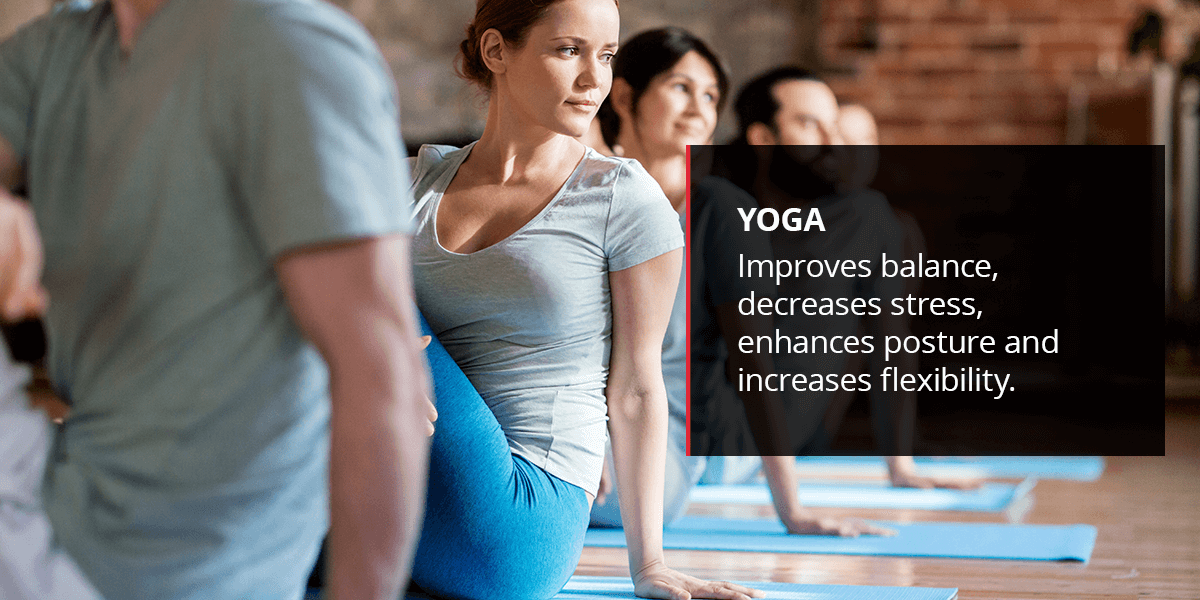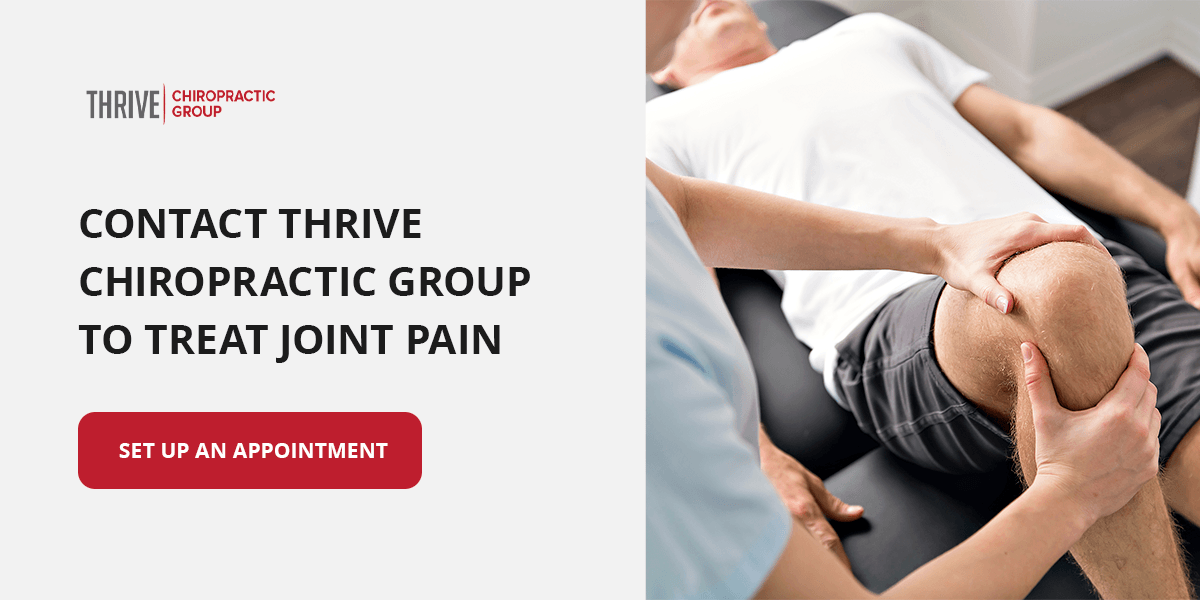Whether you’re looking to relieve joint pain or recovering from an injury, low-impact exercises are a great way to break a sweat without straining your joints. Swimming, walking, rowing and yoga are safe for all ages and highly effective in working muscles. Though they are easier on the joints, they can still pack a punch. You only need to increase your pace and intensity to raise your heart rate.
If you’re unfamiliar with low-impact exercise, we’ll break down what it is, the benefits and what activities meet the criteria.
What Is Low-Impact Exercise?
Low-impact exercise is any workout that doesn’t place a lot of strain on your joints. You usually have at least one foot on the ground when you do low-impact exercises, so there is no jumping, and your body doesn’t have to brace for impact. For the exercise to be low-impact, the activity must not stress your joints excessively. Also, low-impact fitness routines generally have more fluid movements.
It’s essential to differentiate between low-impact and low-intensity exercises — people often confuse the two. Impact is the amount of stress the movement puts on your body, whereas intensity relates to effort. Low-impact exercise can still be intense. An example is rowing. This exercise is low-impact because you do it while sitting and do not run or jump, but you can challenge yourself by increasing your rowing power and speed. Walking on flat ground is a low-impact, low-intensity exercise. Both these exercises have their benefits — it depends on your goals.
Benefits of Low-Impact Exercises
There are several perks to doing low-impact exercises.
Lowers the Risk of Injury
According to research, you’re less likely to get injured doing low-impact exercise like walking than when you do high-impact exercise. Consider a static lunge versus a jumping lunge. When you do a static lunge, you remain stationary and put less pressure on your joints. A jumping lunge is an explosive, plyometric move that requires both feet to leave the ground, so doing this exercise puts more strain on your body.
Low-impact exercises are also excellent when recovering from an injury. You can strengthen your body without worsening your injury or overexerting your joints and muscles.
Improves Mental Health
Studies have shown exercise can reduce anxiety and depression and improve your overall mood. Exercise promotes beneficial brain changes that include neuronal growth, reduced inflammation and new activity patterns that prompt feelings of calm. It also releases feel-good hormones known as endorphins that energize your spirits.
Stress can cause insomnia, headaches, gastrointestinal issues and other symptoms. This discomfort can perpetuate chronic stress and anxiety. Low-impact exercise can help you break free of this cycle. Besides releasing endorphins, it also relieves tension and stress. When your body feels better, your mind can improve, too.
Enhances Stability and Balance
Many low-impact exercises require one foot to be on the ground, so you can expect them to challenge your stability and improve your core strength. If you have ever done yoga or Pilates, you’ll know that these exercises often require you to hold poses that require balance. As you progress, the moves become more challenging. Still, you can improve with consistent practice.
Decreases the Risk of Diabetes
Many low-impact exercises can lower your chances of developing Type 2 diabetes. In one study, people reduced their risk of this chronic condition by combining a healthy diet with frequent low-impact exercise. Strength training also manages your blood sugar levels.
Improves Heart Health
Doctors often recommend walking to people with cardiovascular disease because it is a relatively safe way to stay active. A trial analysis found that walking helps increase the heart’s aerobic capacity, lowers blood pressure and decreases body mass index. The Physical Activity Guidelines for Americans recommend at least 150 minutes of moderate-intensity walking to reap the benefits.
Soothes Joints
If you have trouble with joint pain, you can still enjoy exercise without discomfort. Low-impact exercise does not stress joints and can relieve pain and improve joint health and function. Physical activity can also help delay the onset of arthritis.
Strengthens Bones
Weight-bearing exercises are essential for building bone density. While low-impact exercises like cycling and swimming won’t strengthen your bones, studies have shown that low-impact strength training slows bone loss and can even build bone. With age, our bone mass declines — strength training can combat this loss. Low-impact exercise gives bone-forming cells the nudge they need, resulting in denser bones.
Low-impact exercise is ideal if you want to avoid fractures. It targets and strengthens areas in the body that are most likely to break in a fall, such as your hips, spine and wrists.
Boosts Brain Health
Low-impact exercises can boost brain health in a few ways, including promoting the growth of new brain cells that are essential for cognitive function. These exercises protect your brain from neurodegenerative diseases like dementia and Alzheimer’s. Low-impact workouts increase oxygen flow to the brain. While exercising can’t completely prevent or cure these neurodegenerative diseases, it can delay their onset.
Exercise is also an easy way to improve your thinking skills. Start with 150 minutes of brisk walking per week to start reaping the cognitive benefits.
Supports Weight Loss
When combined with a healthy and balanced diet, low-impact exercises can be excellent for weight loss. They help you burn calories to reach the calorie deficit needed to lose weight. Of course, some exercises burn more calories than others, so consider this if you want to lose weight.
Some low-impact exercises require a lot of effort and challenge various muscles without overworking your joints. Muscle is a metabolically active tissue that burns more calories at rest than fat. When paired with a healthy diet, this can help support weight loss.
Low-Impact Cardio Workouts
Plenty of low-impact exercises will test your cardiovascular and musculoskeletal systems, challenging your muscles without stressing your joints.
Walking
Walking combines simplicity and effectiveness. The only equipment you need is a pair of sturdy, supportive athletic shoes. It’s an excellent alternative for anyone who wants to avoid the stress of running and jogging. Walking on a track or trail instead of concrete can also help take pressure off your joints. A gentle stroll can be soothing, but you can increase your heart rate if you challenge yourself to go faster.
Focus on powering through your hips and legs to increase your speed and burn more calories. Engage your core as you walk and push off your back foot to help you accelerate and move with pace. Bend your arms at a 90-degree angle and keep them close to your body.
You can also incorporate high-intensity interval training to burn more calories — alternate one to three minutes of fast walking with 30 to 60 seconds of slow, recovery walking.
Swimming
Swimming is the ultimate low-impact exercise because it is joint-friendly for all ages. Buoyancy in the water supports your weight and keeps your workout stress-free. It still challenges your body by combining strength, cardio and flexibility. For example, a stroke like freestyle engages muscles throughout your upper and lower body, namely your shoulders, triceps, pecs, quads and core.
To increase the intensity, try this interval workout — swim 10 laps of 30 to 45 seconds each, with 15 seconds of rest between. If you want to raise your heart rate, increase your pace.
Cycling
If you’re looking for an alternative exercise to running, cycling can help you get a similar intensity and adrenaline rush without straining your joints. You can hit the streets or ride a stationary bike in a cycling class — both will benefit your heart, muscles and lungs.
If you opt to cycle outdoors, you’ll need to invest in the right gear, such as a helmet, padded shorts and a bike. Choosing the appropriate bicycle and riding with the seat in the correct position are crucial for protecting your joints. To get correctly set up, visit your local bike shop or ask an instructor at the gym to help you.
Elliptical
If you have access to an elliptical machine, it’s another excellent way to enjoy a low-impact workout. This cardio equipment works your lower and upper body, targeting the glutes, quads, hamstrings, chest, back, biceps, triceps and core. To reap the full benefits of this exercise:
- Set the elliptical settings to your height and body type.
- If you want to increase your workout intensity, consider the following interval workout — 30 seconds at your fastest pace, followed by 15 seconds of recovery.
- When you’re in recovery mode, keep your legs moving at a gentler pace.
Yoga
Yoga is a low-impact exercise with several physical and mental advantages. It improves balance, decreases stress, enhances posture and increases flexibility. Yoga is also an exercise that’s accessible to all ages. You can join studio classes or download an app to enjoy at home.
Pilates
Pilates consists of slow, low-impact movements that focus on building core strength, improving spinal alignment and enhancing body awareness. You can enjoy multiple health benefits by doing a regular Pilates routine, including relieving back pain and tension while increasing your flexibility, coordination and balance. While the workouts focus on strengthening muscles, you may not necessarily get an intense cardio workout from Pilates. However, this primarily depends on your fitness level and chosen class.
Rowing
For a total-body strength and cardio workout, turn to the rowing machines at your gym. Rowing targets your arms, legs and core and can improve your back strength and posture. Remember to keep proper form when you’re rowing:
- Start by selecting your resistance. Sit on the rower and bend your knees to strap your feet in. Lean forward to grab the handles, then sit up, keeping your back straight, chest lifted and position your shins vertically.
- Push away from the machine with your legs, sitting back and pulling the handles toward you, just below your ribs. Keep your knees slightly bent and core engaged, with a slight lean back in your upper body.
- Next, extend your arms, lean slightly forward from your hips and bend your knees to return to the start position.
Barre
This ballet-inspired workout includes pulsing movements. Barre focuses on mobility and flexibility and can also enhance your balance and stability. Depending on the class you go to, you can also get a good dose of cardio and endurance. It’s an excellent way to reap physical benefits without pounding your joints.
Skating
If you’re looking for a new challenge, consider skating. It’s a great way to enjoy the outdoors, exercise and have fun. When you skate, you also challenge your body to move differently than it does if you’re walking or running. The side-to-side motion offers a counterstimulus to the lower body muscles and joints. It works your glutes, hip abductors and inner thighs, too.
Circuit Training
Circuit training is ideal when you’re short on time and still want to fit in a challenging, low-impact workout at home. You can do these three exercises for a low-impact 15- to 20-minute fitness routine. Add a pair of gliding discs to get your heart pumping.
Squat thrusts are much like burpees but without the push-up.
- Place a disc under each foot and stand with your feet hip-width apart.
- Sit back and bend into a squat position.
- Place your hands on the floor and slide your feet on the discs until you are in a plank position. Hold for one second.
- Return to the squat, plant your feet and drive through to stand up tall. Reach your hands over your head.
- Repeat this for 30 seconds and rest for 30.
After the squat thrusts, move onto a plank to pike to push-up.
- Place a glider under each foot. Go into a plank position with your hands on the floor slightly wider than shoulder-width apart and feet hip distance apart.
- Keeping a straight spine, lift your hips to the ceiling. Lower with control, returning to your plank position.
- Keep your body straight and lower straight down into a push-up, inhaling as you bend down and exhaling as you push back up into a plank.
- Repeat this exercise for 30 seconds, then rest for 30 seconds.
You can finish off your circuit with touchdown jacks.
- Place a glider under each foot and stand with your heels together and toes apart. Extend your arms over your head.
- Slide your right leg out to the side, lower down into a squat and touch the floor with both hands.
- Slide your leg back in, stand tall and reach your hands to the ceiling.
- Repeat the exercise on your left and continue alternating.
- Do this for 30 seconds and then rest.
You can repeat this sequence as many times as possible in 15 or 20 minutes.
Contact Thrive Chiropractic Group to Treat Joint Pain
Low-impact exercises are an excellent way to build strength and get your heart pumping without stressing your joints. Shake up your routine with options like walking, swimming, Pilates and circuit training, so you’ll never get bored. You can work out at the gym or in the comfort of your home.
While low-impact exercises help you reach your fitness goals without stressing joints, it is vital to relieve any discomfort that might prevent you from sticking to a consistent workout routine. Joint pain tends to affect those who:
- Repeatedly use or overuse muscles
- Have previous injuries
- Have arthritis or other chronic conditions
- Struggle with depression, stress or anxiety
- Are overweight
If any of these issues apply to you, we can help you relieve and treat your joint pain and support your wellness goals. To learn more about our services and start your journey to a pain-free life, contact us today and schedule an appointment at our South Oklahoma City, Edmond, or Moore locations!

